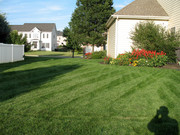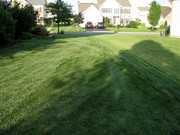I hacked down the jungle-like growth out there that a week of intermittent rain set off. This morning, 13.6 pounds per thousand of Milorganite went down as an interim feeding. I should be noticing increased green from the iron by mid-week as we're getting some rain today.
I'd fed with soybean meal on July 28th, just before an earlier rainy period, and will feed again around September 10th with soybean meal. The final organic feeding will be around October 1st, with winterization around Thanksgiving using a synthetic.
Yes, fall is the time to feed your lawn. Synthetics should wait for
the temperatures to break downward a bit (we usually say Labor Day).
Organics can start any time from August first through Labor Day and be
just fine.
Optimally, you'll want to deliver about three quarters of your lawn's
nitrogen in fall as more of it goes into root storage and development
than in spring. Feeding once around Memorial Day is sufficient for the
spring lawn.
The other feedings, assuming using an off-the-shelf synthetic, in my
area are Labor Day, October first, and whenever the grass stops growing
(for me, around Thanksgiving).
That last one is actually the most important as almost all the
nitrogen is transformed into carbohydrates and stored for winter.
Winter survivability rises dramatically in lawns that were
"winterized," or fed just after cessation of top growth.
Since my area inconsistently freezes, I use Vigoro Super Green with a
goodly percentage of slow-release nitrogen. Areas further north would
do better using the cheapest fast-release (no "WIN" listed under
nitrogen on the bag's nutrient panel) fertilizer you can lay hands on at
bag rate.
Sunday, August 18, 2013
Milorganite Down!
Monday, August 12, 2013
What Works Faster: Milorganite or Ironite?
This is another question that showed up in my search results--apparently Milorganite and Ironite are frequently compared head to head.
They really shouldn't be as they're completely different things. Milorganite is an organic feeding that happens to contain a large percentage of iron. Ironite contains a large percentage of iron and happens to contain a very tiny amount of nitrogen.
As far as speed of greening, both Milorganite and Ironite will give essentially identical results. Enough of the iron is water-soluble that it'll reach the roots at about the same speed for each product after watering in (or rainfall). While Ironite has a bit more iron, it's not significant at bag rate applications.
As far as feeding, Ironite will give a tiny boost of nitrogen. Milorganite will give a much larger one (there's ten times more nitrogen in Milorganite), and about two-thirds of the nitrogen in Milorganite releases over the long term. Organic nitrogen requires time to decay, process, and become available to the plant roots.
Milorganite will help enhance your soil over time as well, although the process is rather slow--on the order of years, not weeks or months.
If you read my posts from this weekend, Milorganite is the heavy-hitter in my gardens (and often in the lawn, although less so this year). Ironite...I don't use the stuff, personally, as the unit price is more expensive when comparing both the iron and the feeding capability of Milorganite. Add in the soil alterations and there's no comparison. It's Milorganite hands down!
Sunday, August 11, 2013
Easter Eggplant
Easter Eggplant is an eggplant that produces fruit the size and shape of Grade A chicken eggs. The "eggs" start out a creamy off-white, something like eggshells, and turn yellow as they mature. Colors can range into orange as they get older.
As it turns out, that description of the Easter Eggplant is accurate. Several of the older eggs on my plants are beginning to turn, and I discovered a set this morning that are now fully yellow. They're on one of the most beaten-up plants in the corner of the garden that sits in full sun all day long.
As always, click on the photo to embiggen it!

Watering in Milorganite and Soybean Meal
I noticed a search term rising in my stats report and it's a good question. How much water does Milorganite need?
Technically, none. You don't need to water in an organic fertilizer to get it to work. Natural rainfall will do that for you very nicely, and neither Milorganite nor soybean meal (nor any other organic fertilizer) will burn if you don't water it in. That assumes you've applied a reasonable amount as large amounts of Milorganite can burn, but bag rate to double bag rate certainly won't be a problem.
Milorganite contains some water-soluble nitrogen, so until it's watered in nothing is happening at all. Around a quarter inch of rainfall or irrigation is sufficient to move that water-soluble N into the soil to start work.
Soybean meal contains no water soluble nitrogen, so there's no immediate nitrogen release at all when watered in no matter how much water you use. Other organic fertilizers will vary, but the percentage of water soluble nitrogen will tell you how much effect to expect immediately after watering.
The remaining sixty percent (or 100 percent for soybean meal) of water insoluble nitrogen has to decay and break down in the soil to become available to your plants. That's dependent on moisture as well, so a constantly slightly to moderately damp environment will feature the fastest nitrogen release.
Too much water tends to expel oxygen from the soil, which is necessary for decay. Soy and Milorganite will still decay under anaerobic conditions, but the results aren't quite as good. Too little water will shut down decay and stop nitrogen release until rainfall resumes.
This is actually a good thing. Soils that are too wet or too dry don't foster large amounts of plant growth to begin with, so reduced nitrogen release is appropriate for what the plants need at that time.
Saturday, August 10, 2013
My Garden Secret
OK, stop hassling me via e-mail. You know who you are. :-)
There are actually several secrets to making your garden bloom like this.
1) Get A Soil Test. Just like the lawn, or your vegetables, they're stuck in the soil. They can't move. You as the gardener will need to balance the soil appropriately, so get a soil test. I prefer Logan Labs.
Reading it can be difficult. For the most part, you want saturation percentages of 60% calcium, 15% magnesium, 10% potassium, 15% everything else. Give or take some, and it does depend on what you're growing--those numbers are for typical annuals.
As a general rule, 250-500 PPM phosphorus is best for flowering gardens, but I've pushed mine far higher. You don't really need to do that.
Adjust things appropriately and your gardens will bloom.
2) Milorganite. 18-36 pounds per thousand square feet, applied monthly. Milorganite will provide some water-soluble nitrogen, but also adds plenty of organic nitrogen that will take a while to decay into your soil. At first, those amounts may be too large and you may find that it smells very bad as it decays. If so, back off for a while until the scent fades and apply at lower levels the next time. Slowly step it up.
Milorganite is probably the most important feeding I give the gardens.
"I can't get Milorganite!" -- I've also used soybean meal to excellent effect and do occasionally use it instead of Milorganite.
In neither case do you have to specifically water it in. Both the Milorganite and soybean meal will start work the next time you water or it rains, and neither will burn your plants if it sits on the leaves.
3) Water. Wilted, stressed plants won't bloom. Dead plants definitely won't bloom. Keep the soil evenly slightly moist at worst all the time. It's best to water far enough before sunset that the plants have time to dry thoroughly before dark. That reduces fungus issues and also helps keep slugs down a little bit (not much).
4) Other feedings. I have an EZ-FLO hose-end system and use it to inject a quarter-rate feeding once per week into my gardens. Roughly, over the course of a month, I use the same amount of water soluble food that would be recommended for a week.
A hose-end feeder will work just fine. If you're following Tip #2, you don't need a great deal, but it's wise to trickle in a little bit often. Just pass over the plants once, then water in or let the rain carry it in for you.
While I use 15-30-15, I've recently changed to 24-8-16 because my soil tests are coming back with very high phosphorus levels. There's no need for me to add any more.
Early-ish August Photos
For the last few weeks the gardens have been doing spectacularly well, and with the break from the hot weather the grass has now caught up. It's time for more photos.
Per request, I'll share my garden secrets with you in a not-too-distant future post (hint: it's a lot less of a secret than you think).
As always, you can click on any photo to embiggen it.
Here's the standard lawn shot. My apologies for catching my shadow in the image, I generally take these a bit earlier in the day.

I took a photo of the grass from the other side of the property to prove that I actually do work on that. Please note, this is one case where I adjusted the brightness of the photo to compensate for the camera's poor choice of exposure time. I really was trying to photograph the lawn, not the house across the street!

This is the more or less standard back garden shot. You can see it's matured even in the two weeks since the last set of photos!

This is roughly the same view, but taken from the other side to show off the central plants nobody ever gets to see in photos.

Standing on the patio during the evening affords some nice views out as well. There's a row of smaller plants in front of the cleome you don't see in this image, except for a stray volunteer Melampodium and the edges of some zinnia.

I divided my Sky Angel dahlia last year and the daughter plant is finally starting to bloom. This blossom is young yet and still has the tight center and green interior of an immature flower. Those turn to a pale lavender as the bud ages.

The Aurora marigold are doing well, but probably won't make the cut for next year. The plants are smaller than I prefer even if the blossoms are a perfect color.

Beginning Fall Feeding
And happy Solar Fall, which started on the fifth. I forgot about that!
Early to mid-August is the time to start organically feeding the lawn for fall. This gives the protein time to break down and begin to work, which generally takes around three weeks. I'll specify that this is for protein-based feeding only--synthetics can wait until Labor Day, and even Milorganite should be held until the third week of August.
For most of us in the Atlantic region, temperatures break cooler by the third week of August, making any time in the first three weeks of August the correct time to feed.
I went a bit early on July 28th. Now, not quite 2 weeks later, the lawn is going slightly insane. Colors have deepened, growth is accelerating, and spreading is filling in a few minor holes left over from spring. Our very high rate of rainfall doubtless has something to do with that, as do the moderate temperatures.
My personal plan is to feed again towards the end of August with Milorganite, followed by soybean meal in mid-September and again the second week of October. That pretty much closes the year for organic feeding as temperatures will drop quickly after that.
My final feeding will be whenever top growth stops on the lawn, usually around Thanksgiving, and I'll use a synthetic for that.